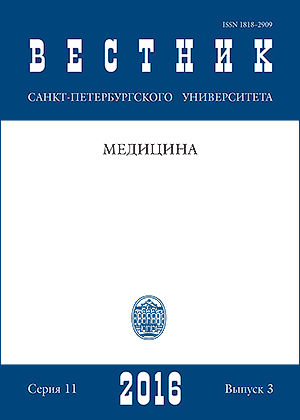CATECHOL-O-METHYLTRANSFERASE POLYMORPHISM (VAL158MET) IN WOMEN WITH UTERINE LEIOMYOMA AND ADENOMYOSIS
DOI:
https://doi.org/10.21638/11701/spbu11.2016.310.Abstract
The aim of this research was to study the frequency of polymorphic variants Val158Met (rs4680) of catechol-O-methyltransferase (COMT) gene in patients with uterine leiomyoma. A polymerase chain reaction was performed to figure out the frequency of polymorphic alleles of COMT gene in 54 patients with uterine leiomyoma and 103 women from the general population. It is shown that the presence of the genotype G/G of the COMT gene is associated with 2.5 times-increased risk of uterine leiomyoma (RR 2,44, Cl95: 1,168-5,103) , whereas the genotype A/A is not associated with the development of leiomyoma. At the same time, a comparative analysis of the genotypes frequencies of the COMT gene polymorphism between groups with different combinations of hyperplastic processes of reproductive system (uterine leiomyoma, adenomyosis, hyperplastic processes of endometrium), showed no statistically significant differences. Refs 26. Tables 3.
Keywords:
fibroids, leiomyoma, adenomyosis, hyperplastic process of endometrium, catechol-omethyltransferase
Downloads
References
References
Downloads
Published
How to Cite
Issue
Section
License
Articles of "Vestnik of Saint Petersburg University. Medicine" are open access distributed under the terms of the License Agreement with Saint Petersburg State University, which permits to the authors unrestricted distribution and self-archiving free of charge.




